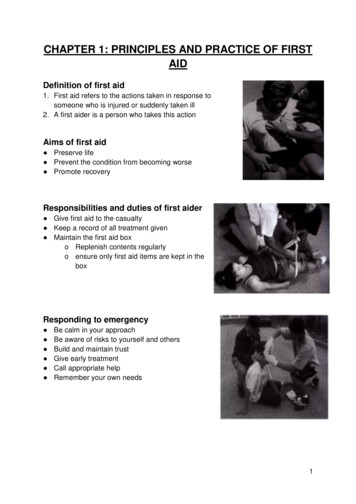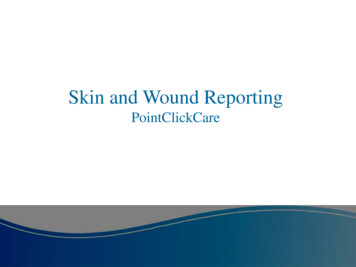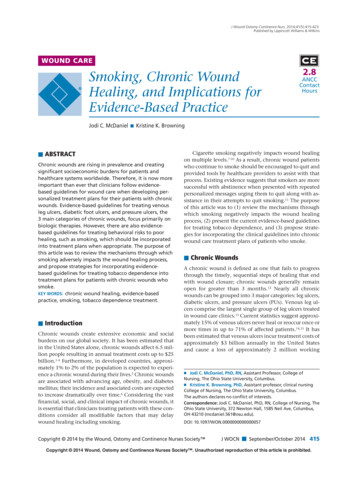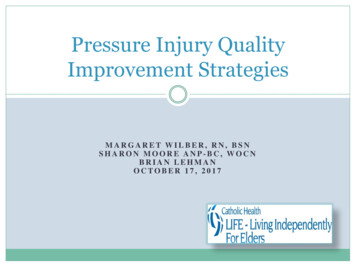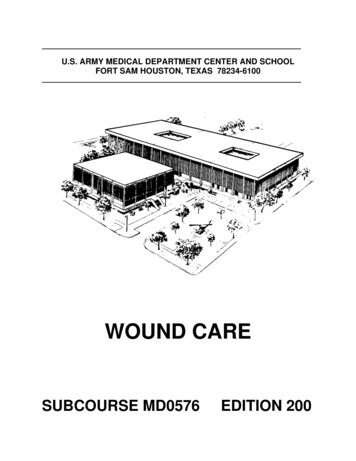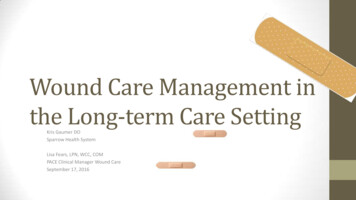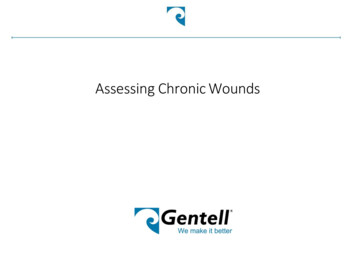
Transcription
Assessing Chronic Wounds
Wound Assessments Should Always Include Wound Type/EtiologyAnatomic LocationStage/ThicknessSize/MeasurementsType of Tissue to the Wound BedWound EdgesExudatePeri WoundS/S of Infection (if applicable)
Type Of Wound/EtiologyDetermining the type of wound you are treating is ofutmost importance, as the treatment plan that is putin place is entirely based off of the wound’s etiology.Typical wounds seen in skilled facilities:Venous UlcerSkin TearPressure UlcerArterial UlcerDiabetic Foot/Neuropathic UlcerSurgical Wound
Anatomic location Be specific as to body part (arm, leg, abdomen, etc.) andthen where on the body part (elbow, medial malleolus,LLQ, etc.) Use words such as: distal/proximal inferior/superior medial/lateral posterior/anterior
Stage/Thickness (cont’d)The Wound Stage/Thickness tells the extent of tissue damage that is visible Only pressure injuries are staged All other wounds are considered Full Thickness or Partial ThicknessA PartialThicknesswound is similartoa Stage 2 PressureInjury; a FullThickness woundis similar to aStage 3 or 4Pressure InjuryPartial ThicknessSkin TearPartial ThicknessBurn InjuryFull ThicknessArterial WoundHealing of a Stage 4 PressureInjury. NEVER backstage aPressure Injury as it heals
Stage/Thickness (cont’d) The Stages of Pressure InjuriesStage 2Stage 1Stage 4Stage 3sDTISuspected DeepTissue InjuryUnstageable
Measuring Wounds Measure in centimeters only Length (head to toe) X Width (side to side) X Depth(straight down perpendicular to skin)WidthLengtOnly measure wherethe wound is actuallyopen. Any peri woundmaceration,discoloration, etcshould bedocumented underthe appropriatecategory
Measuring WoundsUndermining and Tunneling Know the DifferenceWhat is TunnelingA narrow opening or passageway that can extend in anydirection through soft tissue and result in dead spacewith potential of abscess formation. Also known as asinus tract.What is Undermining?The destruction of the underlying tissue surround some or allof the wound margins. May extend in one or many directionsunderneath the wound edge(s).To Measure: Insert a sterile cotton tipped applicator into the tunnel Grasp the applicator at the wound margin Hold to ruler and measure using the Clock MethodTo Measure: Check for undermining at each “hour” of the clock Insert a sterile cotton tipped applicator into theundermining depth Grasp at the wound edge and measure against a ruler Use ranges for undermining areas using the face of the clock(ie. Undermining 1.5cm from 12:00 to 3:00
Type Of Tissue To The Wound Bed Viable, healthy tissue is called Granulation Tissueand is seen in Stages 3 & 4 Pressure Injuries andFull Thickness wounds only Non-Viable, or unhealthy tissue can be either: Eschar - Hard or soft, thick or thin,black/brown/tan tissue Slough - White, yellow or grey; loose, stringy oradherent Non-Viable tissue is only seen in Stages 3 & 4Pressure Injuries and Full Thickness wounds onlyGranulationTissueEschar, Slough andGranulation
Wound Edges Epithelial (Healthy tissue growing from edgeof wound towards center, or may be islandsgrowing within wound bed) Rolled (edges not connected to base ofwound, or unattached; aka “epiboly”) Shape (distinct, irregular, diffuse, defined,etc.) Hyperkeratotic or Calloused (common todiabetic wounds) Macerated (white/boggy from too dEpithelial Tissue
Exudate/DrainageThe amount of exudate you document will dictate the typeand quantity of dressings you can order“Heavy” Exudate“Light” ExudateLess than 5cc of wound fluid within a 24 hr periodFront and back of Gentell’s Waterproof 4x4 foam dressing5cc 1tsp“Moderate” Exudate5cc - 10cc of wound fluid within a 24 hr periodFront and back of Gentell’s Waterproof 4x4 foam dressingGreater than 10cc of wound fluid within a 24 hr periodFront and back of Gentell’s Waterproof 4x4 foam dressing
Exudate/DrainageDocument the color and consistency ofexudate you see on the dressing: Serous (clear fluid) Sanguinous (bloody) Sero-sanguinous (pink) Purulent (thick, yellow/green, can indicatean infection Other (bright green/yellow may indicatepseudomonas infection Odor (mild, strong, sweet, none, etc.)Pseudomonas Infection
Peri Wound (Surrounding) Skin Maceration (usually white fromtoo much moisture) Erythema (redness) Induration (firmness felt aroundthe wound) Edema (swelling around thewound) Temperature (warm, hot, cool,etc.)
Signs of Infection Heat/warm to touch Pain or tenderness Fever Odor Exudate (appearance and/or amount) Swelling/edema Alteration in mental status Tachycardia Hypotension Erythema Induration
Describe These Wounds
References CMS-Guidance to Surveyors for Long Term CareFacilities, F309,F314 Evidence Based Management Strategies for Treatmentof Chronic Wounds: 2009, Frank Werdin MD Acute and Chronic Wounds-Ruth A Bryant, 4th edition 2014 Prevention and Treatment of Pressure Ulcers:Clinical Practice Guidelines
then where on the body part (elbow, medial malleolus, LLQ, etc.) Use words such as: distal/proximal . Evidence Based Management Strategies for Treatment of Chronic Wounds: 2009, Frank WerdinMD Acute and Chronic Wounds-Ruth A Bryant, 4th edition 2014 Prevention and Treatment of Pressure Ulcers: Clinical PracticeGuidelines.


